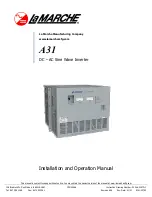
INCORPORATED
®
Installation
ITC-Series
Inverter
Page 19
Owner‟s Manual 10/7/05
Control/Display unit can be plugged into the P6 jack who would be configured as a
slave
.
System ON/OFF Switch
Use this rocker switch to turn the system ON and OFF and to reset the system. This switch is located on the
front panel of the system. If placed in the “OFF” position, this switch will override the operation of a remote
ON/OFF switch connected to terminals 7 and 8 of the Options connector shown in Figure 3-1
– Customer
Terminations.
WARNING:
The System ON/OFF Switch does not interrupt the DC input power to the system, so it must
be noted that dangerous DC voltages still exist inside the unit, even if the power switch is turned off.
Remote Signal Contacts
Terminal Contacts provide capabilities for Remote Inverter Power ON/OFF and Power indication, Remote Low
Battery Warning or Fan On indication, and GenStart control. Contacts are rated 2 amps at 24 volts, Class 2
circuits. Wiring connections are made through an 8 position Options terminal block. Screw pressure-clamp
terminals accept up to 14-gauge wire.
A remote power switch will control the system by tying terminals 7 and 8 of the options connector (shown in
Figure 3-1) together. This will actuate an internal relay that turns the control power on. The Power On/Off
switch on the front panel defeats this remote switch.
In addition, a terminal for a remote LED indicator is provided (terminal 6) with a current limiting resistor integral
to the circuit.
INSTALLATION
Unpacking the Inverter
Inspect the shipping container and equipment for loose or damaged parts. If any damage is found, immediately
notify the freight carrier.
Basic Guidelines
The wiring of your inverter installation should conform to the National Electric Code (NEC) and any other state
or local codes in effect at the time of installation. These codes have been written for your protection and their
requirements should be followed.
Mounting
Locate a secure, dry, flat horizontal surface large enough to mount the inverter. The location should be as
close to the battery as possible without being in the same compartment and should provide adequate
ventilation to maintain room temperature while the inverter is operating. The location must allow unobstructed
cooling airflow at sides, rear, and bottom of the unit, and the location must be free from road spray, dripping
water or other moisture contamination. A recommended minimum clearance of 4 inches (102 mm) should be
maintained on all sides of the unit.
WARNING:
Risk of fire or explosion
. The inverter must not be mounted in fuel storage areas, battery
compartments, or other hazardous areas where potentially explosive gases may be present.
WARNING:
It is important to utilize the included mounting brackets mounting. Mount the inverter in the
under cabinet method or bolted to a shelf
.
There
must be a minimum of 5/8 inches below the unit
, which
provides adequate airflow to cool the Inverter/Charger. If the unit is to be set on its base (in a shelf mount
configuration) and not bolted down, make certain that the mounting feet are bolted to the unit to provide the
adequate clearance as shown below.













































